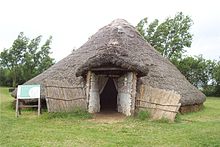Flag Fen
Flag Fen is an archaeological site in Peterborough , England . The open-air museum of the same name located there shows a number of Bronze Age finds, interpretations and reconstructions.
The Bohlenweg
The base of the museum is an approximately one kilometer long boardwalk that was built during the Bronze Age (between 1350 and 950 BC) and connects the two dry "islands" Fengate and Northey. The path consisted of five parallel rows of posts that supported the wooden footbridge. It is estimated that over 60,000 timbers were used in its construction. It is believed that the five rows did not coexist, but that each rotten row was supplemented by another set of posts. A section of the boardwalk is shown in situ in the Preservation Hall and features a jumble of rotten wooden posts, but maps and pictures help to classify the scene for the visitor.
Round houses
Bronze and Iron Age round houses are available as reconstructions . The interiors of the buildings made of wickerwork and clay and roofed with peat and straw are surprisingly spacious and equipped with carved benches, beds and wooden vessels and ceramic bowls, looms and stoves, etc. There is also a small museum on the premises that displays many of the finds from Flag Fen and the surrounding archaeological sites. These include the remains of the oldest wheel discovered in Britain, as well as some daggers, swords and spearheads from the Bronze Age that were believed to have been laid in the waters of Fen as ritual sacrifices.
Wood
Other archaeological sights are various pieces of wood that explain the long-term preservation, which is mainly done by soaking in tanks, by means of numerous information boards that explain the various processes.
Flag Fen's technical skills are also used in discoveries made elsewhere. After the wooden remains of a Timber Circle , known as Seahenge , found on the beach at Holme-next-the-Sea in Norfolk , were excavated in the spring of 1999 , they came to Flag Fen. Here they were subjected to an initial treatment lasting several years in order to counteract the impending deterioration and were also extensively examined and measured. The final preservation took place at the Mary Rose Trust in Portsmouth from 2003 and has now been completed. The pieces are now in King's Lynn in the Lynn Museum , where half of them are on public display.
Roman road
Flag Fen also has a Roman road. The Fen Causeway is the only major Roman road that crosses the Fens , a moorland in eastern England, and was built not long after the Roman invasion of Britain in the mid-1st century AD.
Individual evidence
- ↑ Seahenge - ancient wooden circle ( Memento from July 4, 2008 in the Internet Archive ) on the Flag Fen website, as of July 4, 2008, retrieved from the Internet Archive on September 24, 2012. (English)
- ↑ Seahenge. Prehistoric timber circle from Holme. Information brochure of the Lynn Museum, digitized version ( memento of the original dated August 30, 2012 in the Internet Archive ) Info: The archive link was inserted automatically and has not yet been checked. Please check the original and archive link according to the instructions and then remove this notice. , PDF file, 3.5MB, accessed September 24, 2012.
Web links
- Flag Fen on Peterborough Common Museum and Heritage Site
- Description and pictures on a website about stone circles
- Museum page on facebook
literature
- Francis Pryor : The Flag Fen Basin. Archeology and environment of a Fenland landscape. English Heritage, London 2012, ISBN 978-1-850-74753-6 ( online ) (not evaluated).
Coordinates: 52 ° 34 ′ 28.2 " N , 0 ° 11 ′ 23" W.
